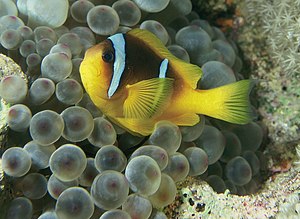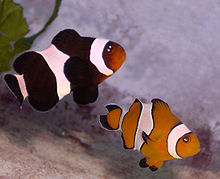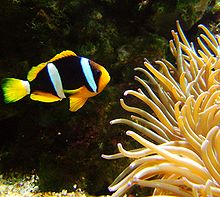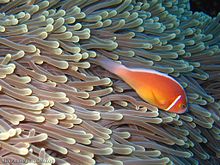Anemonefish
| Anemonefish | ||||||||||||
|---|---|---|---|---|---|---|---|---|---|---|---|---|

Red sea anemonefish ( Amphiprion bicinctus ) in a bubble anemone ( Entacmaea quadricolor ) |
||||||||||||
| Systematics | ||||||||||||
|
||||||||||||
| Scientific name | ||||||||||||
| Amphiprion | ||||||||||||
| Bloch & Schneider , 1801 | ||||||||||||
Anemone fish ( Amphiprion ) - after the two known species, one of which ( ocellaris Amphiprion , ocellaris clownfish ) by the film Finding Nemo gained worldwide recognition, often clown fish called - are in the coral reefs of the tropical Indo-Pacific occurring species of damselfish (Pomacentridae) that lives in close symbiosis with sea anemones . The individual species only live together with certain types of symbiotic anemones. The symbiotic anemones offer the anemonefish, all of which are bad swimmers, protection from predatory fish. The anemonefish also protect their symbiotic partners from predators, e.g. B. Butterflyfish . Assumptions that the fish would feed their partners could not be confirmed, but symbiotic anemones whose fish partners have been caught will soon be eaten by butterfly or filefish .
The anemonefish, which grow to be between eight and 15 centimeters long, feed on zooplankton , some also on algae.
features
Anemonefish grow to be 7 to 16 centimeters long. The body length is 1.7 to 2.5 times the body height. Your dorsal fin is supported by 8 to 11 hard and 14 to 20 soft rays, the anal fin has 2 hard and 12 to 15 soft rays. The number of pectoral fin rays is 16 to 21, that of the scales along the lateral line 31 to 59, and that of the Branchiostegal rays 17 to 22.
distribution
All species live in the tropical areas of the Indo-Pacific and where tropical warm ocean currents reach far to the north or south, e.g. B. on the east coast of Japan, at depths of one to 15 meters. Amphiprion bicinctus is found in the Red Sea . Most of the species have a relatively narrow range, only Clark's anemonefish ( Amphiprion clarkii ) is distributed almost over the entire tropical Indo-Pacific. As an ecological generalist, he also accepts all anemones as symbiotic partners. The region around New Guinea is the most species-rich , with 10 species living near Madang and eight species in the D'Entrecasteaux Islands . Other West Pacific areas, such as Guam or Lizard Island in the Great Barrier Reef, are home to five species. In the Red Sea there are two species, in the Comoros only one and the coasts of Hawaii are without anemonefish.
Reproduction
Anemonefish are initially male after reaching sexual maturity. They live in polyandry , a female with several males, in one or a small group of anemones. The dominant, largest animal in an anemone is always the only female. If the female dies, the strongest male turns into a female. The conversion process begins immediately, but takes a total of 1 year or more to complete. According to recent research, anemonefish are the first animal example in which the conversion takes place first in the brain and then in the sexual organs.
The eggs are laid near the base of the anemone. The male cleans the substrate at the foot of the anemone before spawning. After the eggs have been laid, the clutch is cleaned by the male for seven to eight days with the mouth and fanned with the pectoral fins. A clutch contains around 250 eggs.
After a week, the larvae hatch, which initially have a planktonic way of life, but strive to stay as close as possible to their place of birth. The larval stage lasts two to three weeks. Then the juveniles strive for an anemone to the next coral reef.
Systematics
The 29 species of the Amphiprion genus are grouped into five sub-genera according to common color patterns, one of which is further split into 2 groups. The velvet anemonefish ( Premnas biaculeatus ) differs from its relatives by a sting on the gill cover . However, through the successful crossing of the velvet anemonefish with Amphiprion ocellaris , it has been found that it is so closely related to the other anemonefish that the assignment to a separate genus cannot be justified.
The anemonefish do not have such a prominent position within the damselfish that they can form their own subfamily, as in Allen, 1991. According to various phylogenetic studies, Premnas biaculeatus is the basal sister species of all other anemonefish or the sister species of the clown fish ( A. ocellaris & A. percula ) and the clade they form is the sister group of all other anemonefish.
species
There are 29 Amphiprion species, which are grouped into five sub-genera, as well as the genus Premnas , which is phylogenetically probably within Amphiprion . The species of the same subgenus usually only differ in color and can easily be crossed with one another in the aquarium. In the sub-genus Amphiprion , the species are divided into two groups, those that are close to Clark's anemonefish, which have two distinct transverse bands with a brownish, orange-yellow or black base color, and those that are close to the hot charcoal anemonefish, a red base color and none or only have the bandage over the gills.
- Genus Premnas
- Velvet anemonefish ( Premnas biaculeatus (Bloch 1790) )
- Genus Amphiprion
- Actinicola subgenus (actual clownfish)
- Real clownfish ( Amphiprion percula (Lacepède, 1802) )
- False clownfish ( Amphiprion ocellaris Cuvier, 1830 )
- Subgenus Amphiprion , clarkii complex
- Allard's anemonefish ( Amphiprion allardi Klausewitz, 1970 )
- Barrier reef anemonefish ( Amphiprion akindynos Allen, 1972 )
- Chagos anemonefish ( Amphiprion chagosensis Allen, 1972 )
- Clark's anemonefish ( Amphiprion clarkii (Bennett, 1830) )
- Three-banded anemonefish ( Amphiprion tricinctus Schultz & Welander, 1953 )
- Madagascar anemonefish ( Amphiprion latifasciatus Allen, 1972 )
- Mauritius anemonefish ( Amphiprion chrysogaster Cuvier, 1830 )
- Oman anemonefish ( Amphiprion omanensis Allen & Mee, 1991 )
- Orange-fin anemonefish ( Amphiprion chrysopterus Cuvier, 1830 )
- Red Sea Anemonefish ( Amphiprion bicinctus Rüppell, 1830 )
- Seychelles anemonefish ( Amphiprion fuscocaudatus Allen, 1972 )
- Subgenus Amphiprion , ephippium complex
- Barber's anemonefish ( Amphiprion barberi Allen, Drew & Kaufman, 2008 )
- Australian anemonefish ( Amphiprion rubrocinctus Richardson, 1842 )
- Charcoal anemonefish ( Amphiprion ephippium (Bloch, 1790) )
- McCulloch's anemonefish ( Amphiprion mccullochi Whitley, 1929 )
- Blackfin anemonefish ( Amphiprion melanopus Bleeker, 1852 )
- White-banded charcoal anemonefish ( Amphiprion frenatus Brevoort, 1856 )
- Subgenus Paramphiprion
- Goldentail anemonefish ( Amphiprion sebae Bleeker, 1853 )
- Saddle spot anemonefish ( Amphiprion polymnus (Linnaeus, 1758) )
- White- banded anemonefish ( Amphiprion latezonatus Waite, 1900 )
- Subgenus Phalerebus
- Collared anemonefish ( Amphiprion perideraion Bleeker, 1855 )
- Maldives anemonefish ( Amphiprion nigripes Regan, 1908 )
- Pacific anemonefish ( Amphiprion pacificus Allen, Drew & Fenner, 2010 )
- Orange anemonefish ( Amphiprion sandaracinos Allen, 1972 )
- Thielles anemonefish ( Amphiprion thiellei Burgess, 1981 )
- White-backed anemonefish ( Amphiprion akallopisos Bleeker, 1853 )
- White Riding Hood anemonefish ( Amphiprion leucokranos Allen, 1973 )
- Actinicola subgenus (actual clownfish)
Aquaristics
Anemonefish are popular pets in saltwater aquariums . They are among the few aquatic ornamental fish that can be farmed, and some commercially interesting species are professionally propagated in large fish farms.
literature
- Daphne G. Fautin, Gerald R. Allen: Anemonefish and their hosts. Tetra-Verlag, 1994, ISBN 3-89356-171-4 . (online) ( Memento from January 7, 2012 in the Internet Archive )
- Gerald R. Allen : Damselfish of the World. Mergus Verlag, Melle 1991, ISBN 3-88244-007-4 .
- Joseph S. Nelson : Fishes of the World. John Wiley & Sons, 2006, ISBN 0-471-25031-7 .
- Koralle, marine aquarium specialist magazine. No. 32, April / May 2005, Natur und Tier Verlag, Münster, ISSN 1439-779X
Individual evidence
- ^ Fautin & Allen (1994), p. 139.
- ↑ Sex change from male to female in the anemonefish Amphiprion ocellari begins in the brain , Spektrum.de SciLogs from August 27, 2019
- ↑ B. Quenouille, E. Bermingham, S. Planes: Molecular systematics of the damselfishes (Teleostei: Pomacentridae): Bayesian phylogenetic analyzes of mitochondrial and nuclear DNA sequences. In: Molecular Phylogenetics and Evolution. 31, 2004, pp. 66-88. (PDF) ( Page no longer available , search in web archives ) Info: The link was automatically marked as defective. Please check the link according to the instructions and then remove this notice.
- ↑ J. Li, X. Chen, B. Kang, M. Liu: Mitochondrial DNA Genomes Organization and Phylogenetic Relationships Analysis of Eight Anemonefishes (Pomacentridae: Amphiprioninae). In: PLoS ONE. 10 (4), 2015, p. E0123894. doi: 10.1371 / journal.pone.0123894
Web links
- Anemonefish on Fishbase.org (English)








